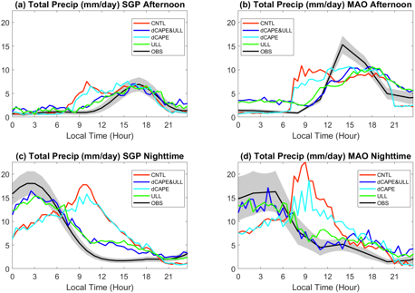Improving diurnal cycle of precipitation with a new trigger: ARM observations and SCM tests
Submitter:
Xie, Shaocheng — Lawrence Livermore National Laboratory
Wang, Yi-Chi — Research Center for Environmental Changes Academia Sinica
Area of research:
General Circulation and Single Column Models/Parameterizations
Journal Reference:
Science
Current weather and climate models continue having difficulties in modeling the diurnal variation in precipitation. Over land, most models tend to rain too early after sunrise with a rainfall maximum around the local noon rather than the observed late afternoon peak and fail to capture the observed nocturnal peak. Earlier studies indicate that the problem is likely related to the unrealistic strong coupling of convection to surface heating in the models. A recently developed convective triggering function by Xie et al. (2019) uses the large-scale dynamic convective available potential energy (dCAPE) as a constraint combined with an unrestricted air parcel launch level (ULL) to relax the unrealistic strong coupling of convection to surface heating and capture nocturnal elevated convection. The new trigger has dramatically improved the diurnal cycle of precipitation simulated by the DOE Energy Exascale and Earth System Model (E3SM). In this study, we attempt to understand how well the underlying physical mechanisms of the dCAPE&ULL trigger are supported by the observations and what relative roles dCAPE and ULL play in simulating the diurnal cycle of precipitation in various deep convection regimes with Atmospheric Radiation Measurement (ARM) data.
Impact
The diurnal cycle of precipitation is one fundamental mode of climate variability that climate models need to accurately simulate. Doing so will have significant effects on surface energy budget and hydrology. The diurnal cycle of precipitation is also an excellent measure of how well climate models simulate not only the total amounts of precipitation, but also its frequency, intensity, and duration, which all have important climate impact.
Summary
By using both case study and statistical analysis of observations from ARM at its Southern Great Plains (SGP) and Manacapuru, Brazil (MAO) sites, this study provides strong observational support for the dCAPE&ULL convective trigger described in Xie et al (2019). Sensitivity tests with the single-column model (SCM) version of E3SM show that dCAPE effectively suppresses spurious daytime convection, in particular under a tropical environment, while ULL plays a bigger role in improving rainfall diurnal cycle by catching nocturnal elevated convection and suppressing morning convection. The combination of these two methods yields better results than applying these two mechanisms individually.


